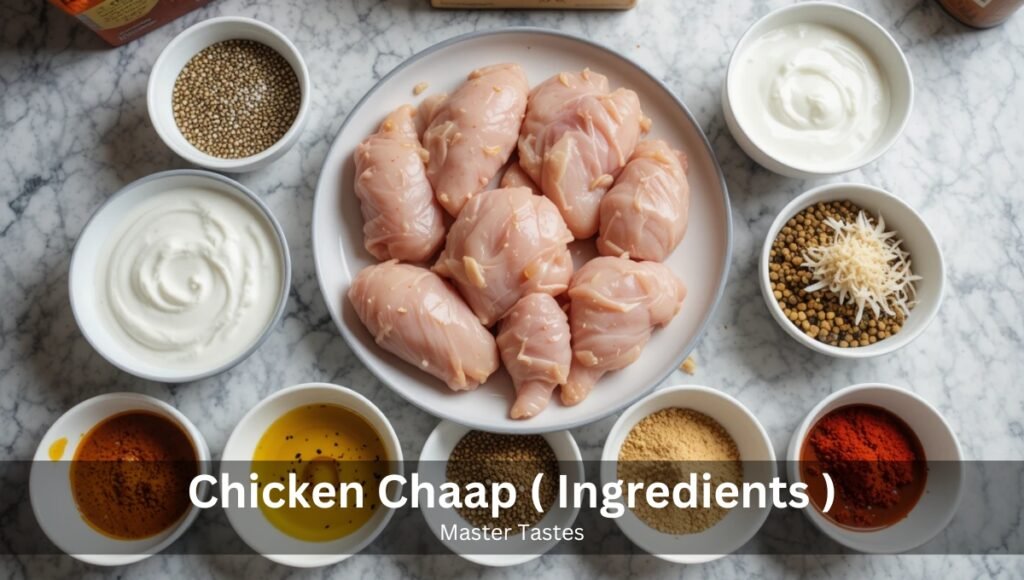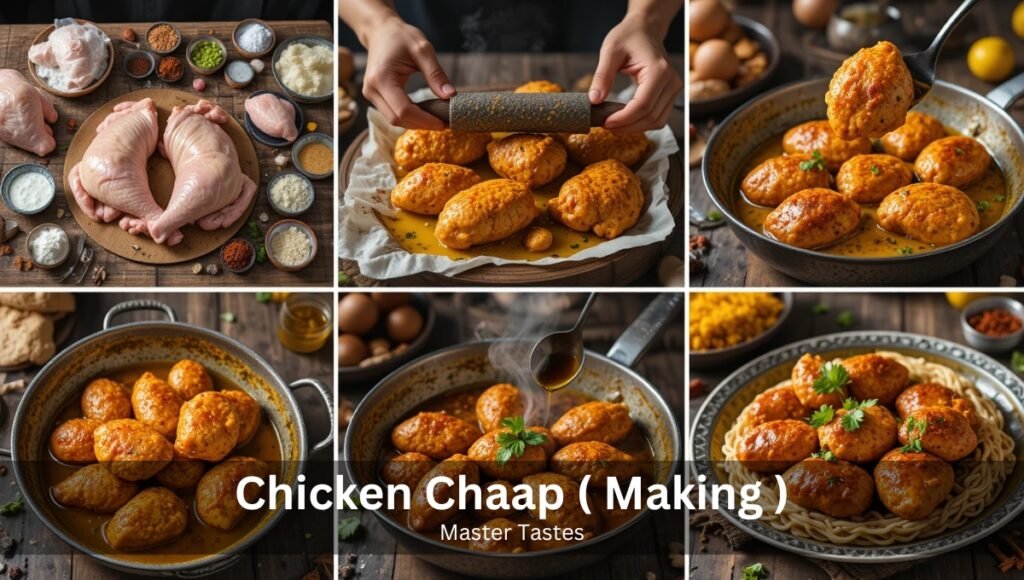Chicken Chaap is a rich and flavorful dish that comes from the Mughal era and became famous in Kolkata’s Mughlai cuisine. It is made by marinating chicken in a mix of yogurt, spices, and poppy seed paste, then slow-cooked in ghee or mustard oil until soft and juicy. This dish is best enjoyed with Biryani, Rumali Roti, or Butter Naan, making it a perfect meal for special occasions. There are many types of chaap, including Punjabi Chaap, Afghani Chaap, and Soya Chaap, which is a vegetarian alternative made from soybeans. Some people confuse Chicken Chaap with Chicken Chup, but they are different dishes. If you love deep, smoky, and rich flavors, Chicken Chaap is a must-try!

Ingredient
| Ingredient | 0.5 kg | 1 kg | 2 kg |
|---|---|---|---|
| Chicken (thighs/breasts) | 0.5 kg | 1 kg | 2 kg |
| Ginger paste | 0.17 tbsp | 0.5 tbsp | 1 tbsp |
| Garlic paste | 0.17 tbsp | 0.5 tbsp | 1 tbsp |
| Chili powder (spicy) | 0.33 tbsp | 1 tbsp | 2 tbsp |
| Coriander powder | 0.33 tsp | 1 tsp | 2 tsp |
| Garam masala | 0.08 tsp | 0.25 tsp | 0.5 tsp |
| Black pepper | 0.17 tsp | 0.5 tsp | 1 tsp |
| Mustard seeds (ground) | 0.33 tsp | 1 tsp | 2 tsp |
| Mustard oil | 0.67 tsp | 2 tsp | 4 tsp |
| Salt | 0.33 tsp | 1 tsp | 2 tsp |
| Lime juice | 0.33 tbsp | 1 tbsp | 2 tbsp |
| Besan (chickpea flour) | 1 tbsp | 1/4 cup | 1/2 cup |
| Corn starch | 0.67 tbsp | 2 tbsp | 4 tbsp |
| Oil (for frying) | As needed | As needed | As needed |

How to Make
Prepare the Chicken
- Wash the chicken well. If it has bones, remove them.
- Place a sheet of plastic wrap (clingfilm) on a cutting board. Put the chicken on top, then cover it with another sheet of plastic wrap.
- Use a heavy object like a rolling pin or a meat hammer to gently flatten the chicken until it is about half an inch thick. Be careful not to tear the meat.
Marinate the Chicken
- Put the chicken in a bowl.
- Add all the ingredients except the chickpea flour (besan) and corn starch.
- Mix well so that all the spices coat the chicken properly. Rub the seasoning into all the small parts of the chicken for the best flavor.
- Now, add the chickpea flour and corn starch. Mix everything again with your hands to create a thick coating on the chicken.
- Cover the bowl and let it rest in the fridge for at least 30 minutes. If you have time, marinate it overnight for even better taste.
Cook the Chicken
- Heat a pan on medium heat and add oil. The oil should cover about half the thickness of the chicken for the best frying results.
- Once the oil is hot, gently place the chicken pieces into the pan.
- Reduce the heat to medium-low and fry the chicken until it turns a deep golden brown. Flip the pieces halfway through.
- It should take about 12-15 minutes to cook completely. Don’t overcrowd the pan; fry in batches if needed.
Serve and Enjoy
- Once the chicken is cooked, take it out of the oil and place it on a plate. No need to drain the oil, as it adds extra flavor to the dish.
- Serve hot with parathas and fresh salad. Enjoy your crispy, flavorful chicken! 😋
History of Chicken Chaap
Chicken Chaap is one of the most celebrated dishes in Mughlai and Bengali cuisine. It carries the elegance of royal kitchens, the richness of slow-cooked spices, and the legacy of centuries-old culinary traditions. This dish is not just about taste; it is a story of cultural fusion, tradition, and passion for food.
The Mughal Origins – A Dish Fit for Royalty
The roots of Chicken Chaap trace back to the Mughal Empire, a period known for its grand feasts and luxurious dining traditions. The Mughals were passionate about food, often bringing Persian, Turkish, and Indian flavors together to create unique and indulgent dishes. Chicken Chaap is believed to have evolved from such experiments in the royal kitchens of Mughal emperors.
Mughal cuisine was known for its use of dry fruits, nuts, aromatic spices, and slow-cooked meats. The concept of marination was central to their cooking, making meats more flavorful and tender. Chicken Chaap followed this tradition, using a special marinade of yogurt, ghee, poppy seeds, and aromatic spices to soften the chicken and give it a royal taste. Unlike regular chicken curries, which are cooked in a gravy, Chicken Chaap was designed to be semi-dry, where the thick masala sticks to the meat, enhancing its richness.
As the Mughal rule spread across different parts of India, their cuisine also started merging with local cooking styles. Bengal, with its rich food culture, embraced this dish and gave it a unique twist. This led to the birth of Bengali-style Chicken Chaap, a dish that still holds a special place in Kolkata’s culinary scene.
The Rise of Chicken Chaap in Bengal – A Culinary Transformation
When the Mughals ruled over Bengal, many of their chefs, known as khansamas, started settling in cities like Murshidabad and Kolkata. These chefs worked for local nawabs and aristocrats, bringing the grandeur of Mughlai food to Bengal. However, as time passed, Bengali influences started blending with Mughal flavors, giving birth to something unique.
One of the biggest changes in the Bengali version of Chicken Chaap was the use of mustard oil. Unlike North Indian Mughlai dishes that relied on ghee or butter, Bengalis preferred the sharp, pungent taste of mustard oil. This small change added a distinct flavor, making the Bengali Chicken Chaap different from its Mughlai ancestor.
Another key addition was the use of special garam masala, which included Bengali spices like black cardamom, nutmeg, and mace. These spices gave the dish a richer and deeper aroma, making it stand out. The cooking process also became more refined – the marination time increased, and the slow-cooking technique became more precise, ensuring the chicken absorbed every bit of flavor.
Kolkata – The City That Kept the Legacy Alive
Kolkata, known as the cultural capital of India, has played a major role in preserving the tradition of Mughlai food. Even today, some of the oldest Mughlai restaurants in Kolkata, such as Shiraz, Arsalan, Royal Indian Hotel, and Aminia, are famous for serving authentic Chicken Chaap. These restaurants have been using the same cooking techniques for decades, making sure the dish retains its original flavors.
A true Kolkata-style Chicken Chaap is always served with Biryani or Rumali Roti. This combination became a favorite among locals and travelers, making Chicken Chaap a must-have dish in Bengali celebrations, weddings, and special occasions.
The Secret Behind the Unique Taste of Chicken Chaap
The most important part of making Chicken Chaap is the marination. Unlike other chicken dishes, where spices are added during cooking, Chicken Chaap requires the meat to be marinated for hours. The chicken is soaked in a blend of yogurt, ginger-garlic paste, poppy seed paste, cashew paste, and aromatic spices. Some chefs also add a touch of saffron and kewra water to give it a royal aroma, just like in the Mughal era.
Once marinated, the chicken is slow-cooked in ghee and mustard oil, allowing the flavors to seep deep into the meat. The slow cooking technique ensures that the chicken remains tender and juicy, while the masala forms a rich coating around it.
Another special technique used in authentic Chicken Chaap is basting. The chicken is cooked in a way that the oil and ghee keep getting poured back onto the meat. This helps in locking the moisture inside, making the chicken soft and full of flavor.
Unlike many chicken dishes that have a thick gravy, Chicken Chaap has a rich, clinging masala that makes it perfect for pairing with Biryani or Indian bread. The balance of creamy, spicy, and slightly smoky flavors is what makes this dish stand out.
The Modern Adaptations – A Dish That Evolves with Time
Over time, Chicken Chaap has seen several modifications based on regional preferences and modern cooking methods. In some places, chefs replace cashew paste with almond paste for a nuttier taste. Others add extra cream to make the dish more indulgent. Some even cook Chicken Chaap in an air fryer or pressure cooker to save time, while still keeping the traditional flavors intact.
In Bangladesh, a similar version of Chicken Chaap exists, but with a heavier use of mustard oil and green chilies, giving it a spicier and sharper taste. Some restaurants also serve a grilled version, where the marinated chicken is cooked on charcoal instead of being fried in ghee, adding a smoky aroma.
Even in Kolkata, different restaurants have their own secret twists. Some use rose water instead of kewra, while others add a touch of mace powder for an extra kick. Despite these variations, the essence of Chicken Chaap remains the same – a dish that is rich, flavorful, and full of heritage.
What Makes Chicken Chaap So Special?
- Deep Mughal-Bengali history – A dish born in the royal kitchens and perfected in Kolkata.
- Unique cooking technique – Long marination, slow cooking, and special basting methods.
- Rich and creamy texture – Uses poppy seeds, nuts, and yogurt for a luxurious taste.
- Perfect balance of spices – Mughal-inspired flavors mixed with Bengali mustard oil and garam masala.
- Iconic pairing with Biryani – A classic Kolkata combination loved by generations.
- Adaptations across regions – Different versions exist in Bangladesh, Hyderabad, and modern kitchens.
Chicken Chaap – A Dish That Stands the Test of Time
Today, Chicken Chaap is more than just a dish; it is a symbol of Bengali-Mughlai cuisine. It represents the perfect blend of royal Mughal flavors and bold Bengali spices, creating an experience that is both comforting and luxurious.
Whether enjoyed in a famous restaurant in Kolkata or cooked at home with love, Chicken Chaap continues to hold a special place in the hearts of food lovers. Its slow-cooked richness, creamy texture, and deep, aromatic flavors make it a timeless favorite that has been passed down through generations.
From the grand courts of the Mughals to the bustling streets of Kolkata, Chicken Chaap has remained a beloved dish for centuries. It is not just food—it is history on a plate.
FAQ’s
How is chicken chaap made?
Chicken Chaap is made by marinating chicken in a mix of yogurt, spices, poppy seed paste, and nuts. The chicken is then slow-cooked in ghee or mustard oil until it becomes soft and juicy. The thick masala sticks to the chicken, making it rich and flavorful.
What is the origin of chicken chaap?
Chicken Chaap comes from the Mughal era and became popular in Bengal, especially in Kolkata. It was first cooked in royal kitchens and later became a famous dish in Mughlai restaurants.
What to eat with chicken chaap?
Chicken Chaap tastes best with Kolkata-style Biryani, Rumali Roti, or Butter Naan. It also goes well with a fresh salad and mint chutney.
What is chicken chaap?
Chicken Chup is a different dish that is not very common. Some people use this name for fried or grilled chicken, but it is not the same as Chicken Chaap.
Is chaap good or bad?
Chaap is good if eaten in moderation. It is rich and delicious, but since it uses oil and nuts, eating too much can be heavy on the stomach.
What is Punjabi chaap made of?
Punjabi Chaap is usually made with soya (vegetarian) or mutton. It is cooked with creamy or spicy gravy and has a smoky flavor.
Is soya chaap halal?
Yes, soya chaap is made from plant-based ingredients like soybeans and flour, so it is 100% vegetarian and halal.
What is Afghani chaap made of?
Afghani Chaap is a creamy dish made with soya or chicken. It is marinated in yogurt, cream, and mild spices, then grilled or cooked until soft.
How does chaap taste?
Chaap has a rich and smoky taste. It is soft, juicy, and full of spices. If cooked in cream, it has a mild and buttery taste. If cooked with spices, it is bold and flavorful.





